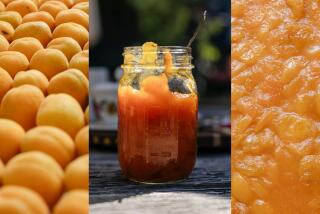Handle With Care
- Share via
If you’ve ever wondered why people line up at the farmers’ markets to pay $10 for a small container of Persian mulberries, then you’ve probably never tasted one. Morus nigra, black or Persian mulberry varieties, are sweet, with twice the sugar of raspberries but with enough acidity to make them irresistibly intriguing. The ancient Near Eastern fruit tastes somehow wilder than blackberries (which they only visually resemble), and the way they liquefy in one’s mouth to a concentrated wine-red nectar is unparalleled by other fruit. It’s a mysterious attraction, for they don’t lure us with perfume the way ripe raspberries or strawberries do. Persian mulberries reserve themselves for our sense of taste alone.
Early one morning in Lucerne Valley, as clouds tempered the high-desert heat, I stood with Alex Weiser, his father, Sid, and their assistant Antonio, and contemplated the row of a dozen dwarf mulberry trees at the Weiser Family Farms. “We planted them a few years ago to distract the birds,” Alex says of the 10-foot-tall, lollipop-shaped trees. “Then we tasted the fruit. Now we’ve got to find the birds another sanctuary.” Sid adds, “Mulberries do well here; our climate duplicates that of the Persian plateau.”
This is the first year the Weisers, known for potatoes, melons and lilacs, have such plentiful mulberries, and Alex was eager to find the best way to harvest the fragile berries. One tree produces 10 bushels of fruit gradually through a season. This means the dense broad-leafed foliage must be combed every couple of days for ripe, black berries. Picked red, they’re too tart and not yet voluptuous with juice; harvested late, they’re dry and cloyingly sweet. Ripe berries often dissolve in the picker’s fingers, reducing yield, but a definite job perk. We plucked, shook, kicked and jiggled trunks and branches to loosen the fruit. As ripe berries dropped into our hands or softly to the ground, we couldn’t resist eating some. This, finally, is why mulberries are costly. If 20% of your harvest is consumed in the field--which is Alex’s personal method of culling his haul--you realize what a rare commodity Persian mulberries are.
Before my visit to the Weisers, I ate mulberries one of three ways: straight from the box at the market, standing in front of my open refrigerator or, on special occasions, from a bowl with a spoon. But I wondered what cooks around town did with the berries. Preserve-maker Edon Waycott turns mulberries from her own tree into jam, “reluctantly, because they lose something when cooked.”
Pastry chefs Kimberly Boyce of Campanile, Kim Sklar of Lucques and executive chef Brooke Williamson of Zax agree. When they can procure them, they serve mulberries simply, with fresh cream or vanilla ice cream and a not-too-sweet cookie. I suppose if I can’t eat them straight from the tree, that’ll have to do.
*
Persian Mulberries with Fresh Cream and Shortbread Buttons (Adapted from Campanile) Serves 6
*--* 1 pound Plugra, or other extra creamy European-style butter Pinch kosher salt 1/2 cup light brown sugar, lightly packed 1 cup powdered sugar 3 1/3 cups pastry flour 1 1/3 cups bread flour 3 cups Persian mulberries with their juices 1 1/2 cups heavy cream
*--*
For shortbread: In the bowl of an electric mixer fitted with paddle attachment, cream butter and salt until very smooth, scraping down sides of bowl, until butter is light and fluffy, about 10 to 15 minutes. Meanwhile, place brown and powdered sugars in a food processor fitted with S-blade and pulverize for 5 minutes. Add sugars to creamed butter. Mix at medium speed until well-blended. Sift flours together and add all at once to butter-sugar mixture. After scraping down sides of bowl, mix just until incorporated. The mixture will be very thick and soft. Turn dough out onto a lightly floured work surface and gather into a ball. Flatten into a disk, wrap in plastic and chill until firm, at least 2 hours or overnight.
Divide dough in half. On a lightly floured surface, roll dough out 1/4-inch thick. With a 3-inch round cookie cutter, cut out as many circles as you can. Save scraps for another use. With a smooth 1/4-inch-diameter pastry tip, punch out four holes in the center of each cookie to resemble a button. Place cookies on a parchment-lined baking sheet. Repeat with remaining dough and bake cookies in middle of 250-degree oven until lightly browned, about 2 hours. Cool on rack. Makes about 2 dozen cookies. Set out six dessert bowls. Spoon 1/2 cup mulberries and their juices into each bowl. Serve with a pitcher of cream and platter of shortbread.
*
Amelia Saltsman last wrote for the magazine on Argentine barbecue.
More to Read
Eat your way across L.A.
Get our weekly Tasting Notes newsletter for reviews, news and more.
You may occasionally receive promotional content from the Los Angeles Times.










